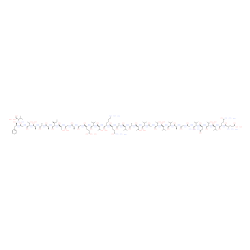α-Synuclein (61-95) (human) trifluoroacetate salt

α-Synuclein (61-95) (human) trifluoroacetate salt结构式

|
常用名 | α-Synuclein (61-95) (human) trifluoroacetate salt | 英文名 | α-Synuclein (61-95) (human) trifluoroacetate salt |
|---|---|---|---|---|
| CAS号 | 154040-19-4 | 分子量 | 3260.61 | |
| 密度 | 1.3±0.1 g/cm3 | 沸点 | 2937.7±65.0 °C at 760 mmHg | |
| 分子式 | C141H235N39O49 | 熔点 | N/A | |
| MSDS | 美版 | 闪点 | 1730.4±34.3 °C |
|
Suppression of Cpn10 increases mitochondrial fission and dysfunction in neuroblastoma cells.
PLoS ONE 9(11) , e112130, (2014) To date, several regulatory proteins involved in mitochondrial dynamics have been identified. However, the precise mechanism coordinating these complex processes remains unclear. Mitochondrial chaperones regulate mitochondrial function and structure. Chaperon... |
|
|
Ellipticine induces apoptosis in T-cell lymphoma via oxidative DNA damage.
Leuk. Lymphoma 56(3) , 739-47, (2015) The tumor suppressor p53 is often mutated in human cancers. Restoring its antitumor activity has been shown to be a promising therapeutic approach for cancer treatment. Here we analyzed the activity and mechanism of a p53 reactivator, ellipticine, in a cellul... |
|
|
Antiviral effect of methylated flavonol isorhamnetin against influenza.
PLoS ONE 10(3) , e0121610, (2015) Influenza is an infectious respiratory disease with frequent seasonal epidemics that causes a high rate of mortality and morbidity in humans, poultry, and animals. Influenza is a serious economic concern due to the costly countermeasures it necessitates. In t... |
|
|
Auranofin induces apoptosis and necrosis in HeLa cells via oxidative stress and glutathione depletion.
Mol. Med. Report. 11(2) , 1428-34, (2014) Auranofin (Au), an inhibitor of thioredoxin reductase, is a known anti‑cancer drug. In the present study, the anti‑growth effect of Au on HeLa cervical cancer cells was examined in association with levels of reactive oxygen species (ROS) and glutathione (GSH)... |
|
|
Unmethylated CpG motifs in the L. donovani DNA regulate TLR9-dependent delay of programmed cell death in macrophages.
J. Leukoc. Biol. 97(2) , 363-78, (2015) Regulation of macrophage PCD plays an important role in pathogenesis of leishmaniasis. However, the precise involvement of any parasite molecule in this process remains uncertain. In the current study, in silico wide analysis demonstrated that genes in the Le... |
|
|
1,25-dihydroxyvitamin D3 causes ADAM10-dependent ectodomain shedding of tumor necrosis factor receptor 1 in vascular smooth muscle cells.
Mol. Pharmacol. 87(3) , 533-42, (2015) 1,25-Dihydroxyvitamin D3 (1,25D3) has a potential antiatherosclerotic effect through anti-inflammatory actions. We investigated how 1,25D3 regulates tumor necrosis factor-α (TNF-α)-induced lectin-like oxidized low-density lipoprotein receptor-1 (LOX-1) expres... |
|
|
Withanolide E sensitizes renal carcinoma cells to TRAIL-induced apoptosis by increasing cFLIP degradation.
Cell Death Dis. 6 , e1666, (2015) Withanolide E, a steroidal lactone from Physalis peruviana, was found to be highly active for sensitizing renal carcinoma cells and a number of other human cancer cells to tumor necrosis factor-related apoptosis-inducing ligand (TRAIL)-mediated apoptosis. Wit... |
|
|
Mechanism of Dose-Dependent Regulation of UBE1L by Polyphenols in Human Bronchial Epithelial Cells.
J. Cell. Biochem. 116 , 1553-62, (2015) Ubiquitin activating enzyme E1-like (UBE1L) is the activating enzyme for ISG15ylation (ISG15, interferon stimulated gene 15). UBE1L is thought to be a candidate tumor suppressor gene and has positive activity against stress responses such as viral infections.... |
|
|
The eucalyptus oil ingredient 1,8-cineol induces oxidative DNA damage.
Arch. Toxicol. 89(5) , 797-805, (2015) The natural compound 1,8-cineol, also known as eucalyptol, is a major constituent of eucalyptus oil. This epoxy-monoterpene is used as flavor and fragrance in consumer goods as well as medical therapies. Due to its anti-inflammatory properties, 1,8-cineol is ... |
|
|
S-Allylmercapto-N-acetylcysteine (ASSNAC) protects cultured nerve cells from oxidative stress and attenuates experimental autoimmune encephalomyelitis.
Neurosci. Lett. 583 , 108-13, (2014) Oxidative stress and/or low cellular glutathione are associated with development and progression of neurodegenerative diseases. We have shown that S-allylmercapto-N-acetylcysteine (ASSNAC) up-regulates the level of glutathione and phase II detoxifying enzymes... |